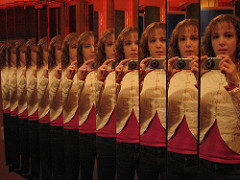I overheard a passing comment in class this week about learning styles, and it was a record needle scratch moment for me.
Learning styles are a hot topic in the education world–they’re the notion that a person may have a specific mode (visual, auditory, or kinesthetic, says one model) through which they like to learn or are best at learning. In class we were talking about orchestrating classroom discussions, and most of the conversation was about how to encourage participation and keep students talking.
One classmate of mine added that when she leads a discussion she likes to keep in mind her students’ individual learning styles, and she structures so that she can reach each student effectively. Something along these lines: Sally is an auditory learner, so ask her to speak up; James is a kinesthetic learner, so throw in a physical activity; etc.
This was validated with a round of sage nods and enthusastic comments by the teacher and several other classmates–they all seemed to think this was smart, just good teaching. But something about her comment rubbed me the wrong way. It felt like I had read somewhere that learning styles were pop psychology, not borne out by research. But I didn’t push back. I waited til I was home and could look it up. And yup, researchers are now saying that learning styles (as people usually think of them) are bogus.
But unfortunately, the publishing industry piled in some time ago, and isn’t likely to be dissuaded from pushing learning styles as a way to differentiate their products. If you’re a parent, there are a dozen different ways to teach your baby—or kindergartner, or middle schooler, or college-bound teenager—that thing you want them to learn right now, each one perfectly tuned to their ideal learning style.
WIRED posted a super clear debunking and distillation: All You Need to Know About the ‘Learning Styles’ Myth, in Two Minutes.
The short version: people often express a favorite mode of learning or activity, but (so far, let’s say) the evidence has simply not borne out that there is any actual personal effect between mode and learning. In other words, setting aside what feels good according to personal preference, individual people doesn’t seem to actually learn more when they learn something in their favorite mode than in other modes.
If I’m grasping it correctly, the idea is that the personal sensation of the activity we’re doing while we’re learning feels to us like it’s directly coupled with the learning itself. Research has so far not established an effect between the two. We need to de-couple them in our personal model of learning, and in our model of teaching.
What have been found, though, are effects between the mode of learning, on the one hand, and the material being learned and the stage of learning on the other.
… although each of us is unique, usually the most effective way for us to learn is based not on our individual preferences but on the nature of the material we’re being taught
Beginners in a given domain may learn best one way (say, through looking at completed sample problems), and experts another way (say, through solving new problems themselves). That picture may look different in another domain. There also seems to be an overall positive effect when learning through mixed modes, and this may in fact apply to every learner, in every domain.
Here’s another good article, this one citing more academic research: The Myth of Learning Styles. The author makes an interesting observation about why the myth is so attractive and persistent: we’re just not very good at assessing what’s happening in our own thinking.
… a growing body of psychological research on metacognition demonstrates that our beliefs about how we process information and how we learn can actually be quite wrong,
Coming back to my seminar mate, the teacher: it may be that a certain lesson she teaches will be better absorbed through motion, or through visual diagrams, or some other mode. But it will be because the content of the lesson is well matched to the affordances of the mode she chooses, not because of any individuals’ learning styles. And she should be encouraged that hitting on a productive teaching mode will help all of her students learn the material, not just the students who think they like the mode she chooses.
So, tonight’s seminar is done and I can’t get back that opportunity to debunk the theory among my classmates. But now I’m armed with research the next time it comes up. Hopefully this will happen less in the future — at least among educators I meet.




